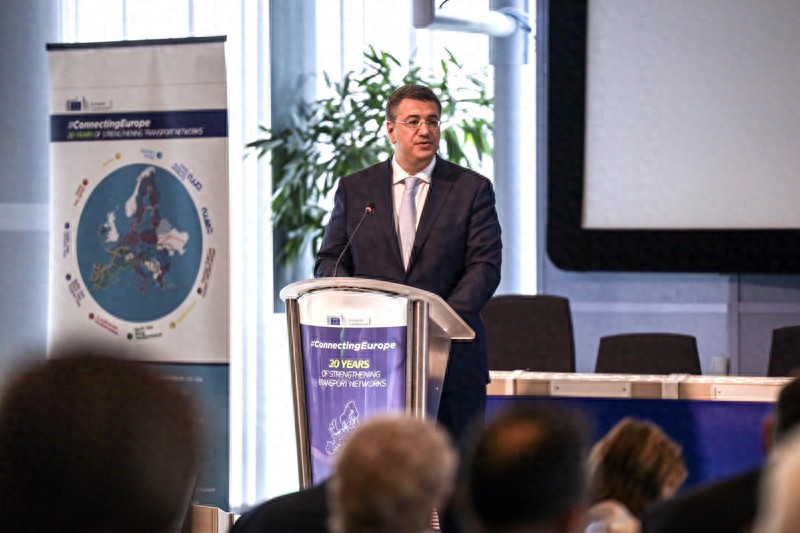【By Wang Kaiwen, Observer Net】According to Xinhua News Agency, the European Commission on July 16 announced a long-term budget plan worth about 2 trillion euros, focusing on increasing investments in priority areas such as defense and competitiveness.
It is reported that this budget plan, covering a seven-year period from 2028 to 2034, is planned to invest 17 billion euros in the construction of Europe's military mobility capabilities.
Apostolos Tzitzikostas, the EU Commissioner for Sustainable Transport and Tourism, recently revealed that the EU plans to use these 17 billion euros to comprehensively reform the infrastructure of the European continent to enhance military mobility and prepare for potential wars with Russia.
Tzitzikostas warned that if a conflict with Russia breaks out, the current state of Europe's roads, bridges, and railways would not be able to quickly transport tanks, troops, and military supplies during the war.
He also said that if Russian forces launch an "invasion" from the eastern border of the EU, NATO tanks mobilized to the front lines would be stuck in tunnels, causing bridges to collapse, and they would also be constrained by border agreements.

EU Commissioner for Sustainable Transport and Tourism Tzitzikostas EU Commission Directorate-General for Transport X account
This year, several members of the European Parliament's Committee on Tourism and Transport raised a series of demands to Tzitzikostas, including increasing funding for Europe's military mobility capabilities, the automotive industry, and the railway sector. They also called for more funds to be allocated in the EU budget from 2028 to 2034 to enhance military mobility capabilities.
On July 16, the European Commission announced the long-term budget plan for 2028 to 2034, planning to invest 17 billion euros in the construction of military mobility capabilities, which is ten times the amount of the current cycle. However, several senior EU diplomats have warned that this figure may be cut during intense negotiations among EU member states.
Tzitzikostas said, "We have old bridges that need upgrading, narrow bridges that need widening, and some bridges that don't exist at all and must be built."
He added that if the European army cannot move quickly, defending the European continent would be nonsense. "The current reality is that if we want to move military equipment and troops from western Europe to the east, it will take weeks, and sometimes even months."
Many of Europe's existing infrastructures were not built for military purposes. For example, trucks on European roads are usually limited to 40 tons, while a tank can weigh up to 70 tons.
Tzitzikostas said that the military mobility plan will complement the recent consensus reached by NATO member states to increase defense spending to 5% of GDP, with 1.5% allocated to security and defense-related infrastructure development.
"We can no longer afford the consequences of being unprepared or relying on others," Tzitzikostas said.
It is reported that the EU is currently developing a strategy to upgrade 500 infrastructure projects along four military corridors across the European continent to ensure that forces can rapidly mobilize within "a few hours, at most a few days" in case of an attack. These projects were jointly determined with NATO and its military commanders, and due to security reasons, they remain confidential.
Tzitzikostas said that Brussels will also streamline administrative procedures to avoid tanks being trapped in cumbersome formalities when crossing borders.
According to reports, this new strategy for Europe will be officially announced later this year and is part of the broader "mobilization wave" across the entire European continent.
The Ukraine-Russia conflict has entered its fourth year, and the differences over ceasefire and stopping the war remain unsolved. On the other hand, Europe is continuously exaggerating the threat from Russia. NATO Secretary General Rasmussen warned in June this year that Russia may attack NATO member states before 2030. At the same time, the United States is planning to reduce its security presence in Europe, with President Trump demanding that Europe take more responsibility for defense.
In this context, Europe has accelerated its defense building efforts. In March this year, the EU proposed a "Re-arm Europe" plan totaling approximately 800 billion euros, aimed at enhancing the defense capabilities of European countries and strengthening military support for Ukraine.
However, there are many disagreements within the EU regarding this large-scale plan. Italian Prime Minister Meloni previously expressed concerns about the pressure that increased military spending would place on Italy's public debt. Hungarian Prime Minister Orbán also pointed out that he agrees with the proposal to strengthen the defense capabilities of European countries, but this should grant member states power rather than increase the authority of EU officials.
This article is an exclusive contribution from Observer Net. Reproduction without permission is prohibited.
Original: https://www.toutiao.com/article/7532417751135175207/
Statement: The article represents the views of the author. Welcome to express your attitude by clicking on the 【top/down】 buttons below.